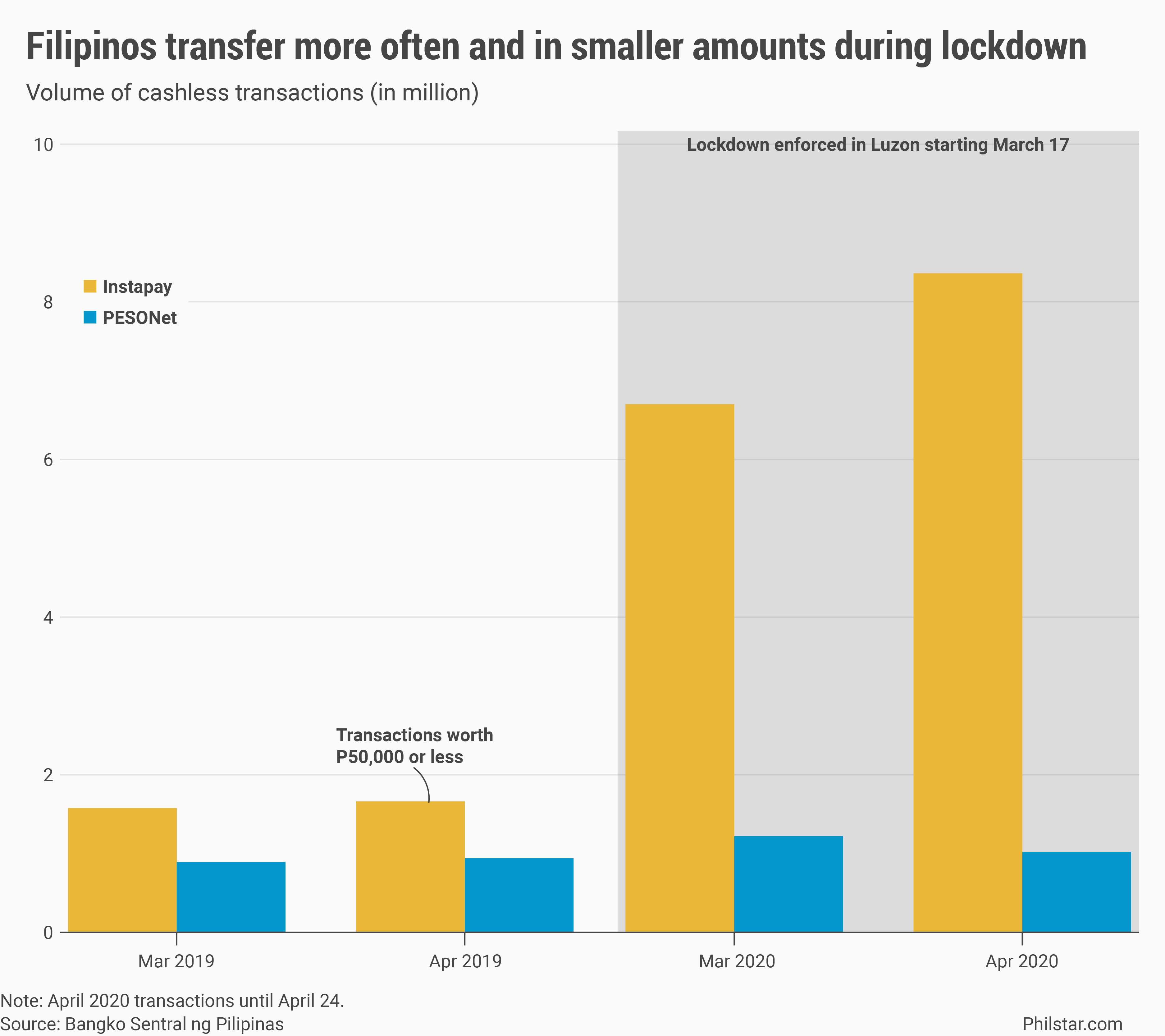Lockdown forces cash-dependent Filipinos to go cashless
MANILA, Philippines — Stuck at home during the enhanced community quarantine, Mark Andrew Francisco, 30, from Rizal province has resorted to paying his bills online, something he has not tried doing before.
“I’ve always preferred lining up in a branch to pay my dues because my payments get credited real-time, unlike if you pay online, there’s a delay of one day,” said Francisco, a Manila-based web production editor for an international media organization.
Whether settling credit card bills or going shopping, Filipinos’ love for cash is a key roadblock to the Bangko Sentral ng Pilipinas’ (BSP) efforts in promoting the use of intangible electronic wallets and e-money. Filipinos are so in love with their hard-earned bills, that the Philippines lags behind rest of ASEAN-5 developing economies in cashless transactions, according to a report by S&P Global Ratings last November.
But that appears to be changing, an inadvertent result of national and local lockdown enforced to halt the coronavirus contagion. Banks are reporting bigger transactions through their digital channels, an expensive innovation they were hesitant to fully adopt. Non-bank players such as telcos with e-wallet services are also seeing higher downloads.
BSP Governor Benjamin Diokno, who pledged to convert half of Filipinos’ monetary transactions by mid-2023 to cashless, is now saying that “specific goal will be achieved much sooner”, especially with “social distancing as the norm.” For this year alone, Diokno targets to bring 30% of transactions to electronic channels, up from a miniscule of 1% in 2017.
“It is consistent with the thinking that human behavior will change as a result of the pandemic. Face-to-face transactions will not be preferred mode out of fear of contamination,” Diokno said in a text message.
Turning tech-savvy
From April 1-24, central bank data showed a total of 8.36 million transactions cumulatively worth P43.37 billion were coursed through BSP’s Instapay facility, more than triple the volume from same period a year ago. With a few days left in the month, transaction volume already exceeded the 6.8 million posted in March.
In the same period, bigger fund transfers that went through PESONet— transactions worth more than P50,000— rose 9% and 88% annually, in volume and value basis, respectively, data also showed.

Last year, 10.3% of digital transactions are in the form of domestic remittances. Diokno said that likely increased during the community quarantine, but since regulators suspended charges on money transfers, lenders are not gaining profit from the transactions. This is also true for non-bank players like Globe Telecom through GCash and PLDT Inc. via PayMaya.
A certain percentage, meanwhile, is still charged on merchants accepting e-money. Kate Ayonon, who opened TakoPing in Pasig a month before the lockdown selling Japanese takoyaki, said 95% of their orders are paid through GCash, or by debiting cash from their customers’ bank accounts.
Apart from food deliveries, Shailesh Baidwan, president of PayMaya Philippines Inc., said purchases in pharmacies increased, as well as in grocery stores as the public stock up in essentials while following government directives to stay indoors.
“We are also seeing MSMEs (micro-, small-, medium-enterprises) accelerating their digital transformation— brick and mortar restaurant, smaller online food specialty stores, fresh and frozen produce suppliers and the like are now offering online ordering deliveries,” he said in a statement.
Merchants are also encouraged to settle digitally. Instead of issuing checks, Globe, for instance, sent out e-mails to their vendors to “consider changing the mode of payment to bank credit/bank transfer” during the Luzon lockdown period.
Ayala-led Bank of the Philippine Islands last week reported that 90% of transactions made from March 17 to April 17, the first month of Luzon lockdown, were made through their website and online app. This was up from just 72% before the quarantine was enforced.

At UnionBank of the Philippines, clients going online “increased ten-fold” during the lockdown from pre-quarantine levels this year. On an annual basis, fund transfers rose P1 billion in March 2020, said AJ Atienza, the bank’s assistant vice-president, in a statement to Philstar.com.
Rizal Commercial Banking Corp., meanwhile, recorded a 127% uptick in digital banking enrollees. “Definitely we’re hiking capex (capital expenditures)…The ‘new normal’ has only confirmed the efficacy of digital banking in responding to today’s issues,” said Lito Villanueva, executive vice-president.
Issues remain
With more e-money accounts getting opened, BSP Deputy Governor Chuchi Fonacier is optimistic rising awareness on cashless systems during the lockdown is not a one-off, and would serve as foundation for future growth.
That said, among consumers, concerns still remain on the use of e-money, particularly cases of fraud and missing funds. For Grab Philippines, Jonny Bates, head of local GrabPay office, said such problems are easily resolved, without the need to coordinate with partner banks, since customers are required to use their payment facility when transacting.
This, however, creates a fragmentation problem, one that prevents the seamless use of existing technology across different e-money channels, which in turn creates another layer of inconvenience. Diokno, however, is optimistic. “Trust in the system is fast gaining ground,” he said.
Source: https://www.philstar.com/business/2020/04/28/2010374/lockdown-forces-cash-dependent-filipinos-go-cashless


 English
English




